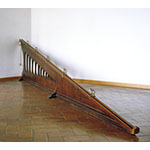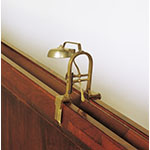This inclined plane, with five small bells and a pendulum, was devised to provide an experimental demonstration of the Galilean law of falling bodies. The apparatus makes use of another important physical principle discovered by Galileo: the isochronism of pendulums of equal length. This principle is demonstrated by the pendulum connected to the plane, which completes its oscillations in equal times. The experiment consists in releasing a small ball from the top end of the plane at the same time as the pendulum is swung. At each successive complete oscillation of the pendulum, the ball strikes one of the small bells placed along the inclined plane at increasing distances, arranged in the sequence of odd numbers. The experiment not only makes it possible to measure the increase in the distances traveled by a body in natural fall in successive and equal time intervals starting from the rest position; it also provides—thanks to the bell rings—an acoustic perception of the ball's constant acceleration during its fall.
No documents survive proving that Galileo performed this specific experiment. In the mid-nineteenth century, Giuseppe Bezzuoli—following the instructions of Vincenzio Antinori, director of the Museo di Fisica e Storia Naturale—represented in a fresco of the Tribuna di Galileo the Pisan scientist conducting an experiment to demonstrate the law of falling bodies by means of an inclined plane.










